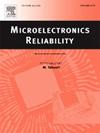Research on high-power high-frequency electrical transmission characteristics of through glass via interconnections
IF 1.9
4区 工程技术
Q3 ENGINEERING, ELECTRICAL & ELECTRONIC
引用次数: 0
Abstract
Through Glass Via (TGV) have attracted significant attention as advanced package solutions. Compared to silicon, glass has lower dielectric losses but thermal conductivity two orders of magnitude lower. This may introduce transmission degradation due to self electro-thermal coupling in high-power, high-frequency signal applications such as RadioFrequency (RF) transceiver and high-performance computing chip package. To address the issue, A Microstrip Resonant Ring (MRR) test structure was designed and fabricated for temperature-dependent high-frequency parameter extraction. Coplanar Waveguide (CPW) and Substrate integrated waveguide (SIW) test structures were designed and fabricated for high-frequency transmission tests at various temperatures. A quadruple redundant TGV connected CPW test structure was designed and fabricated for high-frequency high-power self electro-thermal testing, followed with self electro-thermal coupling simulation to verify experimental results. The research reveals that, under high-power, high-frequency signal input, transmission losses in TGV interconnects are primarily dominated by conductor losses. The optimized quadruple redundant TGV connected CPW test structure demonstrated insertion losses of 0.51 dB, 0.94 dB, and 2.04 dB under input conditions of 10 W@6GHz, 7.9 W@12GHz, and 6.3 W@18GHz, respectively. The corresponding maximum temperatures recorded were 36.2 °C, 38.4 °C, and 55 °C for these operating conditions.

通过互连的穿透玻璃高功率高频电传输特性研究
玻璃通孔封装(TGV)作为一种先进的封装解决方案受到了广泛关注。与硅相比,玻璃具有更低的介电损耗,但导热系数低两个数量级。这可能会在大功率、高频信号应用(如射频(RF)收发器和高性能计算芯片封装)中由于自电热耦合而导致传输性能下降。为了解决这一问题,设计并制造了一种用于温度相关高频参数提取的微带谐振环(MRR)测试结构。设计和制作了共面波导(CPW)和衬底集成波导(SIW)测试结构,用于不同温度下的高频传输测试。设计并制作了四冗余TGV连接CPW试验结构,用于高频大功率自热电试验,并进行了自热电耦合仿真验证实验结果。研究表明,在大功率、高频信号输入下,TGV互连的传输损耗主要由导线损耗主导。优化后的四冗余TGV连接CPW测试结构在10 W@6GHz、7.9 W@12GHz和6.3 W@18GHz输入条件下的插入损耗分别为0.51 dB、0.94 dB和2.04 dB。在这些操作条件下,相应的最高温度记录为36.2°C, 38.4°C和55°C。
本文章由计算机程序翻译,如有差异,请以英文原文为准。
求助全文
约1分钟内获得全文
求助全文
来源期刊

Microelectronics Reliability
工程技术-工程:电子与电气
CiteScore
3.30
自引率
12.50%
发文量
342
审稿时长
68 days
期刊介绍:
Microelectronics Reliability, is dedicated to disseminating the latest research results and related information on the reliability of microelectronic devices, circuits and systems, from materials, process and manufacturing, to design, testing and operation. The coverage of the journal includes the following topics: measurement, understanding and analysis; evaluation and prediction; modelling and simulation; methodologies and mitigation. Papers which combine reliability with other important areas of microelectronics engineering, such as design, fabrication, integration, testing, and field operation will also be welcome, and practical papers reporting case studies in the field and specific application domains are particularly encouraged.
Most accepted papers will be published as Research Papers, describing significant advances and completed work. Papers reviewing important developing topics of general interest may be accepted for publication as Review Papers. Urgent communications of a more preliminary nature and short reports on completed practical work of current interest may be considered for publication as Research Notes. All contributions are subject to peer review by leading experts in the field.
 求助内容:
求助内容: 应助结果提醒方式:
应助结果提醒方式:


